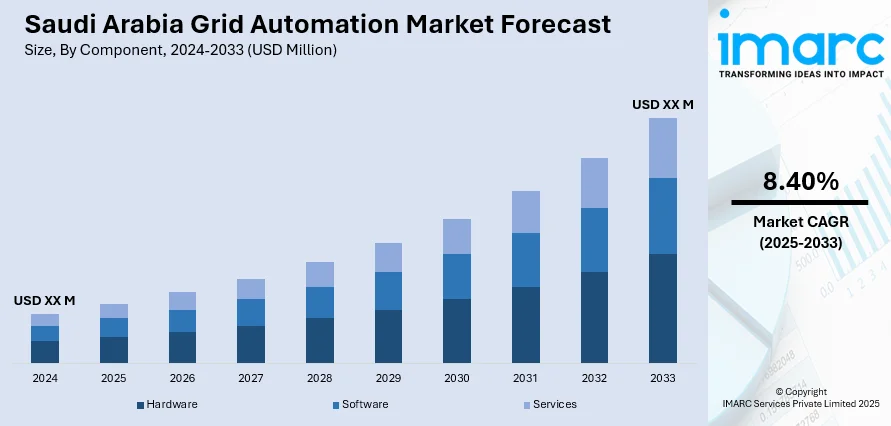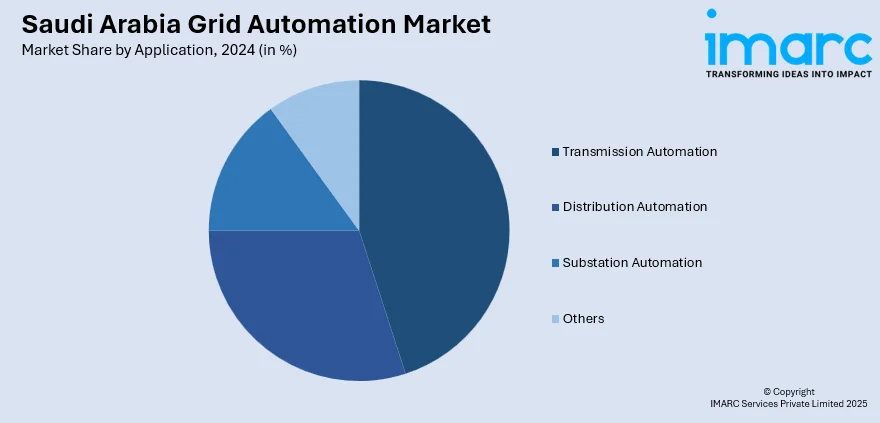
Saudi Arabia Grid Automation Market Size, Share, Trends and Forecast by Component, Application, End User, and Region, 2025-2033
Saudi Arabia Grid Automation Market Overview:
The Saudi Arabia grid automation market size is projected to exhibit a growth rate (CAGR) of 8.40% during 2025-2033. The market is expanding rapidly, driven by investments in advanced grid technologies and digitalization. Major projects, such as the Rumah 2 and Nairyah 2 power plants and the expansion of GEMTEC in Dammam, are enhancing grid efficiency. In addition, Saudi Arabia grid automation market share continues to grow as these initiatives support the Kingdom’s Vision 2030 goals for sustainable energy.
|
Report Attribute
|
Key Statistics
|
|---|---|
|
Base Year
|
2024 |
|
Forecast Years
|
2025-2033
|
|
Historical Years
|
2019-2024
|
| Market Growth Rate 2025-2033 | 8.40% |
Saudi Arabia Grid Automation Market Trends:
Strategic Investments in Grid Automation
Saudi Arabia has significantly advanced its grid modernization efforts through strategic investments in infrastructure. By enhancing grid reliability and minimizing operational downtime, these projects are crucial to transforming the power grid into a more flexible and digitally interconnected system. This investment positions Saudi Arabia as a regional leader in energy efficiency and sustainability. Ultimately, this shift to smart grid infrastructure will pave the way for greater integration of renewable energy sources and will be pivotal to Saudi Arabia's energy security in the future. For instance, in March 2025, Siemens Energy secured a USD 1.6 Billion contract to supply technologies for the Rumah 2 and Nairyah 2 gas-fired power plants. This project, which adds 3.6 GW to the grid, supports Saudi Arabia's grid automation efforts, enhancing operational efficiency and sustainability. These plants are critical in modernizing the Kingdom's power grid, addressing growing energy demands while promoting sustainability. The integration of advanced grid technologies in these plants is aligned with Saudi Arabia's broader goals of modernizing its power generation and distribution networks. The plants are designed to significantly reduce CO2 emissions by replacing outdated oil-fired stations, supporting the Kingdom's Vision 2030 goals for a cleaner, more sustainable energy future. Moreover, their operational efficiencies will contribute to reducing energy transmission losses and increasing grid reliability.

Expansion of Digitalization and Local Automation
Saudi Arabia continues to build a resilient and advanced grid infrastructure with an increased focus on automation and digital technologies. Aligned with this trend, in April 2025, GE Vernova announced a major investment in Saudi Arabia's energy infrastructure, including the expansion of its GEMTEC facility in Dammam for grid automation and digitalization. This expansion is crucial to advancing Saudi Arabia's grid automation capabilities, supporting the Kingdom's goal of modernizing its energy infrastructure in alignment with Vision 2030. The expanded GEMTEC facility will play a pivotal role in the Kingdom's energy transformation, developing and enhancing grid management systems that can support real-time monitoring, optimization, and automation of power distribution networks. These systems will increase grid reliability, provide greater flexibility, and optimize energy management across the Kingdom. Saudi Arabia aims to enhance operational efficiency and facilitate more effective management of renewable energy integration by integrating cutting-edge digital solutions. The focus on local manufacturing and digitalization will also drive job creation and technology development within Saudi Arabia. This investment in local infrastructure will reduce reliance on external sources, boost the Kingdom's energy independence, and create a sustainable, future-proof energy system. These efforts are essential to achieving the Kingdom's Vision 2030 goals of reducing its carbon footprint, improving energy efficiency, driving the Saudi Arabia grid automation market growth.
Saudi Arabia Grid Automation Market Segmentation:
IMARC Group provides an analysis of the key trends in each segment of the market, along with forecasts at the country and regional level for 2025-2033. Our report has categorized the market based on component, application, and end user.
Component Insights:
- Hardware
- Sensors
- Programmable Logic Controllers (PLCs)
- Remote Terminal Units (RTUs)
- Communication Networks
- Software
- Supervisory Control and Data Acquisition (SCADA)
- Distribution Management Systems (DMS)
- Advanced Metering Infrastructure (AMI)
- Grid Optimization Software
- Services
- Installation and Integration
- Maintenance and Support
- Consulting and Training
The report has provided a detailed breakup and analysis of the market based on the component. This includes hardware (sensors, programmable logic controllers (PLCS), remote terminal units (RTUS), and communication networks), software, (supervisory control and data acquisition (SCADA), distribution management systems (DMS), advanced metering infrastructure (AMI), and grid optimization software), and services (installation and integration, maintenance and support, and consulting and training).
Application Insights:

- Transmission Automation
- Distribution Automation
- Substation Automation
- Others
A detailed breakup and analysis of the market based on the application have also been provided in the report. This includes transmission automation, distribution automation, substation automation, and others.
End User Insights:
- Utilities
- Industrial
- Commercial
- Residential
The report has provided a detailed breakup and analysis of the market based on the end user. This includes utilities, industrial, commercial, and residential.
Regional Insights:
- Northern and Central Region
- Western Region
- Eastern Region
- Southern Region
The report has also provided a comprehensive analysis of all the major regional markets, which include Northern and Central region, Western region, Eastern region, and Southern region.
Competitive Landscape:
The market research report has also provided a comprehensive analysis of the competitive landscape. Competitive analysis such as market structure, key player positioning, top winning strategies, competitive dashboard, and company evaluation quadrant has been covered in the report. Also, detailed profiles of all major companies have been provided.
Saudi Arabia Grid Automation Market News:
- April 2025: SEC launched Phase 2 of its battery energy storage system (BESS) development, investing over SAR6.73 Billion. This phase, with 2.5 GW capacity across five sites, supports Saudi Arabia's grid automation efforts, boosting efficiency and enabling integration of 50% renewable energy by 2030.
- March 2025: Siemens Energy secured a USD 1.6 Billion contract to supply technologies for the Rumah 2 and Nairyah 2 gas-fired power plants in Saudi Arabia. This project, adding 3.6 GW to the grid, supported Saudi Arabia’s grid automation efforts, enhancing operational efficiency and sustainability.
Saudi Arabia Grid Automation Market Report Coverage:
| Report Features | Details |
|---|---|
| Base Year of the Analysis | 2024 |
| Historical Period | 2019-2024 |
| Forecast Period | 2025-2033 |
| Units | Million USD |
| Scope of the Report |
Exploration of Historical Trends and Market Outlook, Industry Catalysts and Challenges, Segment-Wise Historical and Future Market Assessment:
|
| Components Covered |
|
| Applications Covered | Transmission Automation, Distribution Automation, Substation Automation, Others |
| End-Users Covered | Utilities, Industrial, Commercial, Residential |
| Regions Covered | Northern and Central Region, Western Region, Eastern Region, Southern Region |
| Customization Scope | 10% Free Customization |
| Post-Sale Analyst Support | 10-12 Weeks |
| Delivery Format | PDF and Excel through Email (We can also provide the editable version of the report in PPT/Word format on special request) |
Key Questions Answered in This Report:
- How has the Saudi Arabia grid automation market performed so far and how will it perform in the coming years?
- What is the breakup of the Saudi Arabia grid automation market on the basis of component?
- What is the breakup of the Saudi Arabia grid automation market on the basis of application?
- What is the breakup of the Saudi Arabia grid automation market on the basis of end user?
- What is the breakup of the Saudi Arabia grid automation market on the basis of region?
- What are the various stages in the value chain of the Saudi Arabia grid automation market?
- What are the key driving factors and challenges in the Saudi Arabia grid automation market?
- What is the structure of the Saudi Arabia grid automation market and who are the key players?
- What is the degree of competition in the Saudi Arabia grid automation market?
Key Benefits for Stakeholders:
- IMARC’s industry report offers a comprehensive quantitative analysis of various market segments, historical and current market trends, market forecasts, and dynamics of the Saudi Arabia grid automation market from 2019-2033.
- The research report provides the latest information on the market drivers, challenges, and opportunities in the Saudi Arabia grid automation market.
- Porter's five forces analysis assist stakeholders in assessing the impact of new entrants, competitive rivalry, supplier power, buyer power, and the threat of substitution. It helps stakeholders to analyze the level of competition within the Saudi Arabia grid automation industry and its attractiveness.
- Competitive landscape allows stakeholders to understand their competitive environment and provides an insight into the current positions of key players in the market.
Need more help?
- Speak to our experienced analysts for insights on the current market scenarios.
- Include additional segments and countries to customize the report as per your requirement.
- Gain an unparalleled competitive advantage in your domain by understanding how to utilize the report and positively impacting your operations and revenue.
- For further assistance, please connect with our analysts.
 Request Customization
Request Customization
 Speak to an Analyst
Speak to an Analyst
 Request Brochure
Request Brochure
 Inquire Before Buying
Inquire Before Buying




.webp)




.webp)












